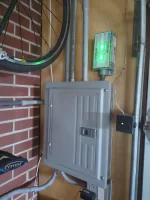- Joined
- Feb 13, 2022
- Messages
- 1,682
- Reaction score
- 1,126
- Location
- Scottsdale, AZ
- Cars
- GT
- Referral Code
- IDLI9CO7
Just gone one installed. About $300 and change. A weird thing about the one I got is that there’s no reset. If a surge occurs, the protector would just get fried and a new one is needed.EV charging won't cause transients on your home's power. If you live in an area with frequent lightning, or like I do, have overhead high voltage lines that are sometimes subject to arcing from nearby tall trees, I think it's definitely worth having a whole-house surge suppressor installed when the electrician has your panel open anyway. Material cost is about $100 and labor is minimal.
I‘ve not heard of this type of surge protector. Supposed to be ”good.”

